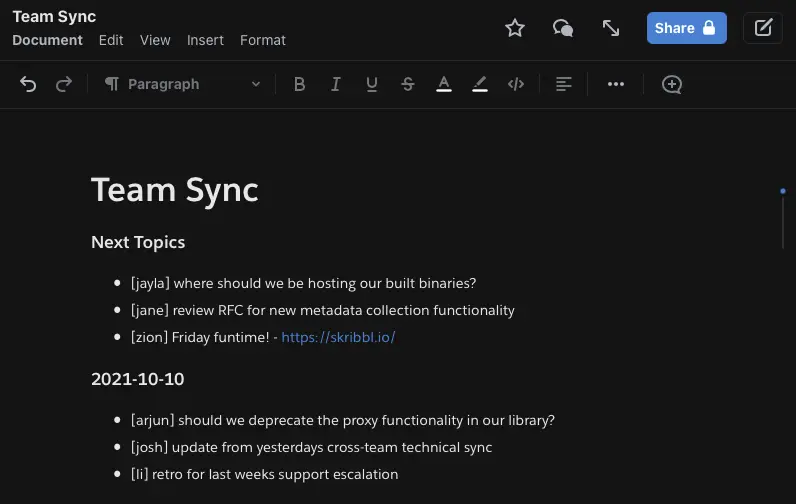Stand-Up Meetings Are Dead (and What to Do Instead)
Stand-up meetings. Is anyone happy with them at this point? They were supposed to help teams work in a more agile manner but they were already controversial in the before times and moving to…

By: Ben Darfler

Stand-up meetings. Is anyone happy with them at this point? They were supposed to help teams work in a more agile manner but they were already controversial in the before times and moving to fully distributed teams hasn’t made things any better. The same old habits, the same tired questions. There must be something better, right?
We began meandering syncs to replace stand-ups as an experiment at Honeycomb, but loved the results so much that we have adopted it across the engineering org. We think you might love it, too! But before I share how that works, let’s first take a look at how we got here.
Stand-up meetings go asynchronous
As the world abruptly cut over to remote work in early 2020, we all scrambled to replicate our existing team practices in this new distributed world. Of course, we all know that distributed work is best done asynchronously, and thus the asynchronous (async) stand-up was born.
In its simplest form, the async stand-up is a team practice of starting the day by answering thethree stand-up questions in your team Slack room and continuing on your way. The simplicity of this approach is alluring. We have checked the stand-up box and embraced the async nature of distributed work in one fell swoop. Easy, right?
Easy indeed … if only it, you know, worked. There might be teams out there doing async stand-ups and loving it, but I have neither met nor heard of one.
The problems with async stand-ups
The first problem that you run into with async stand-ups is the lack of any cue or forcing function. With stand-ups, somebody has to, you know … stand up at the prescribed time. But no matter—let’s add a Slack reminder to our team room! Which helps, but it’s still far too easy to miss in scrollback, and it totally falls apart in the face of a team that spans different time zones. So okay, let’s set up a Slackbot for stand-ups! Slackbots do a fine job with the reminder problem by sending their nagging DMs at time zone–appropriate times. So problem solved? Not so fast.
While stand-up Slackbots solve the logistical issues of a distributed async stand-up, they quickly expose the real underlying problem: No one reads async stand-ups. I’ve tried to read them; really, I have. I know how valuable the information is, and yet I can’t bring myself to consistently read them, and I know damn well I’m not alone.
And if no one reads async stand-ups, the whole thing becomes an exercise in futility. The point of a stand-up is to share context, identify issues, offer help and input, and generally collaborate on the team’s work in a high throughput, in a (dare I even say) synchronous way. If no one reads the async stand-up notes, it fails on every single one of those points and the whole thing becomes the very definition of a waste of time.
This is the point where many teams just give up on stand-ups all together. And that’s not necessarily a bad choice! Just forget the whole thing and go back to shipping cool stuff to customers. However, at Honeycomb, we wondered if we might do it better.
What to do instead of stand-up meetings
Let’s go back to how this whole stand-up thing started. The reason it could be a 10-minute meeting was that all of the team’s needs were already met outside of stand-up. As Seth Godin expertly points out,the real magic of the office was that connection was effortless. Need to follow up on a conversation from stand-up? Chat about it on the way back to your desk. Need a quick review of your design? Grab a co-worker and a whiteboard. Want to welcome the new hire to the company? Head out to lunch together.
But now, most of us don’t have those effortless connections. With most or all of our team members working from home, we need to come up with a way to formalize and create space for these incidental human interactions. We need to make explicit that which was once implicit.
While the stand-up format itself was never conceived to meet these needs, a daily team meeting is the perfect place for them. And rather than keep the meeting short and sweet, let’s deliberately flip that upside down and schedule a long daily meeting instead. With that, I present to you the meandering team sync.
The meandering team sync
What does this “meandering team sync” look like? For my team at Honeycomb, our meetings are an hour a day, five days a week. I can already hear the productivity crowd moaning in the back—but I’m genuinely not sure we could devise a better use of our time.
Our meetings kick off with a casual roll into the Zoom room. It’s not uncommon to have folks join a few minutes or even 5-10 minutes into the meeting. The team spans the U.S. West Coast to the UK, so folks on the earlier side are usually just rolling into work and no one wants to rush to their first meeting. It’s not uncommon to see coffee being sipped or breakfast being eaten as we all assemble.
Once the first few folks join we say our good mornings/afternoons and start to shoot the shit. The first 10-20 minutes of the meeting are purely social. As a distributed remote team that spans multiple time zones, we don’t have the luxury of getting casual social time automatically so we have tobe intentional about our connection time.
Eventually, the person running the sync for the week (we rotate and take turns) has to be the “Party Pooper” (yes, that is a formal designation, as configured by our weekly pager rotation) and move us along to the “work” section of the meeting. The agenda is collaboratively assembled by the team over the previous day by adding topics to a shared sync doc.

Depending on the Party Pooper’s preference, we’ll start by going through the discussion topics for the day or by looking at our project board, whichever seems more valuable.
Why the meandering team sync works
It’s counterintuitive that spending a whole eighth of the week in a team meeting would be a win. What’s going on here?
First and foremost, the reason this works is that we are using a high bandwidth communication medium for its best and highest purpose: creating human connection. If you dig into the “everything async” world you will find the teams that do it best are actually lying. While the “work” might all be async, they still use synchronous communication for the one thing you can’t do well asynchronously: being human together. Creating a daily social space for the team builds trust and compassion. We get to learn about each other’s hobbies, interests, and lives outside of work. We form a deeper understanding of each other, see each other as whole humans, and from that flows the much-touted psychological safety. The investment in time is absolutely worth the returns.
Second, we are optimizing our limited number of overlap hours in a team that stretches from the U.S. West Coast to the UK. While the teammates on either end of that span are graciously flexible with their work hours, we want to get the most out of the few core hours we have with the whole team. And that means spending it looking at each other’s faces and using our mouthwords. This daily meeting means we’re never too far away from a high-bandwidth opportunity to share knowledge or come to a team decision. This keeps the team informed and moving quickly.
Finally, it actually reduces meetings and interruptions for the team. When we have a team retro, we do it during the sync. Weekly, monthly, quarterly planning—it all happens during the sync. Need to coordinate with someone from another team? Invite them to the sync. Need to work through the meat of aSynchronous Sandwich? You guessed it—do it in the sync.
Without this daily hour block, those meetings would probably end up scattered throughout the week, wreaking havoc on everyone’s productive flow. With our daily sync, everyone knows to expect that daily hour and work around it. As a bonus, it’s great for distributing knowledge beyond the engineers who made a change.
How to start moving from stand-up meetings to meandering team syncs
Ease in with some structure. Come prepared with some conversation starters. For instance, on a previous team, we had a practice of going around the room on Mondays and talking about our weekends. This is a great opportunity to both be goofy and learn more about each other as human beings.
Bring the fun. Bring in an online social game sometimes. My team has picked up playingSkribbl on Fridays, and I’m still laughing to myself about the round we played a few hours ago. Don’t let the “mandatory fun time” vibe get to you. I promise no one will remember when you are all cry-laughing at each other’s terrible pictionary skills.
Start with 30 minutes and work up. That’s where we started on my team. At some point, we began scheduling an additional 30 minutes on top of that for specific working sessions, and after a week or two of back-to-back 30-minute meetings working on a particularly collaborative project, we ended up with a permanent hour. If an hour feels dauntingly long to you, try this first!
Don’t go it alone aka focus on team culture. Chat 1:1 with some or all of the team (#protip: share this post!) about your goals for this time so they can help you make it a success. At Honeycomb, we value emotional labor more than most engineering organizations, even factoring it into things like promotions and leveling. So participating in building team culture is a part of everyone’s job at Honeycomb in a way that might not be the case in other engineering organizations.
Just do it. It’s ok if it feels weird at first. If folks aren’t used to unstructured time, it’s definitely going to be awkward to start, and that’s fine. It’s expected! Be clear right up front that this time is reserved for the important work of team building, above and beyond that of “being productive.”
But even if it’s not a “required” element, teams will always work better when they know one another, collaborate more enthusiastically, and find joy in communicating with one another. There are probably some people on your team right now who are hungry for more connection and a sense of group identity and belonging, or even just people who miss the office and getting to hang out together. They’re on your side; they want this, too.
So what do you think? Will you give it a shot on your team? ☺️ Please write us a message in the Slack Pollinators group or send us a tweet and let us know how it goes for you!
Want to know more?
Talk to our team to arrange a custom demo or for help finding the right plan.